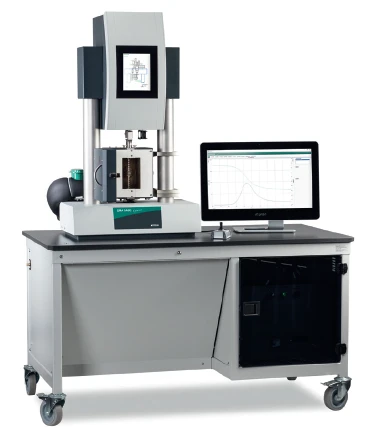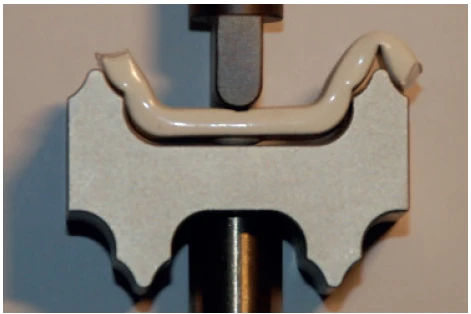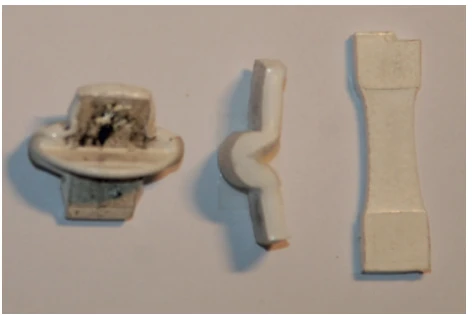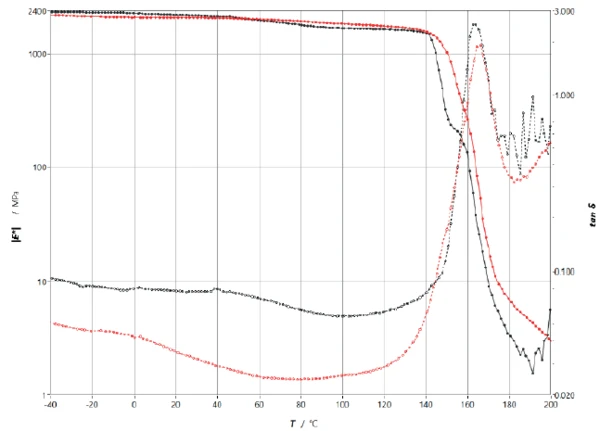A Comparison Between the 3-Point-Bending and Tensile Modes
The Material Polycarbonate
Polycarbonate is a thermoplastic material and – when not reinforced by particles or fibers – softens extremely at higher temperatures. In order to determine the temperature dependence of the mechanical properties or the Glass Transition TemperatureThe glass transition is one of the most important properties of amorphous and semi-crystalline materials, e.g., inorganic glasses, amorphous metals, polymers, pharmaceuticals and food ingredients, etc., and describes the temperature region where the mechanical properties of the materials change from hard and brittle to more soft, deformable or rubbery.glass transition temperature, certain test geometries and special test conditions are required.
Experimental
An Eplexor® 500 N (figure 1) equipped with a 500 N force sensor and a thermal chamber (-160°C up to 500°C) is used for the investigations of polycarbonate (PC white).

3-Point Bending
For many applications, the 3-point bending test is commonly used. Because PC starts softening very “early”, i.e., already many degrees below the glass temperature (Tg), the PC sample tends to sag down under its own weight and touch the bottom before the glass temperature is reached (figure 2). It even adopts the contour of the 3-point bending holder (here: span 30 mm)! This effect accompanies all bending holders independent of their span. PC samples subjected to bending tests undergo complex deformations (simultaneous stretching-shearing-bending) in temperature sweeps. Depending on the material, the deformation may already start at temperatures 10 to 30°C below the glass temperature. The deformation processes a sample experiences in a bending test differ for all temperatures from those occuring in a tensile test. Therefore, in bending tests, the energy dissipation will be higher than in tensile tests because more energy-dissipating processes exist. This finding justifies the expectation that in bending mode, higher tanδ values occur than in tensile tests even if the test material is the same.
Tensile Tests
The better alternative for dynamic-mechanical analysis of PC is the tensile test. All tensile tests have to meet the following requirements:
- Overcome the inherent tendency of sample contraction at higher temperatures
- Assure the planarity of the sample (= prevent buckling)
Suitably configured PC tensile tests minimize the influence of gravity on the sample shape. Conventional tensile tests apply larger static loads than dynamic loads. This avoids the occurrence of alternating loads during the test cycles and thus prevents sample buckling. If one can apply certain measures to exclude the possibility of buckling, then there is no need to follow this rule! In that case, both the static and the dynamic load can be chosen freely to conform to the needs of the experiment. Indeed, buckling does not occur when short samples (with a gauge length of a few millimeters) and small deformations (on the micrometric scale) are used in tensile tests. Such configurations are applied when temperature sweeps are carried out on PC.
Test Conditions
The PC samples used for tensile tests are 9.5 mm wide, 3 mm thick and 30 mm long. A gauge length of about 10 mm results and proves suited for StrainStrain describes a deformation of a material, which is loaded mechanically by an external force or stress. Rubber compounds show creep properties, if a static load is applied.strain-controlled dynamic loads. A low static force amplitude (contact force) keeps the PC sample straight at all times of the test when no data points are being acquired. For comparison, a 3-point bending test (static StrainStrain describes a deformation of a material, which is loaded mechanically by an external force or stress. Rubber compounds show creep properties, if a static load is applied.strain 3%, dynamic StrainStrain describes a deformation of a material, which is loaded mechanically by an external force or stress. Rubber compounds show creep properties, if a static load is applied.strain 1%, contact force 1 N ± 0,5 N, span 30 mm) is also performed.
Figure 3 shows the significant influence of the tension force on the sample’s shapes in 3 examples. It must prevent contraction and not elongate the PC sample significantly. It is obvious that the contact force levels of 0.5 N (figure 3, left and figure 3, center) and 0.75 N are not sufficient. It is the contact force level of 1 N (figure 3, right) that keeps the sample straight and doesn’t elongate it excessively.
Actually, the required force limitation shrinkage depends on the material and the sample’s cross-sectional area!
Static deformations of 50 μm (0.5% static StrainStrain describes a deformation of a material, which is loaded mechanically by an external force or stress. Rubber compounds show creep properties, if a static load is applied.strain) and dynamic deformations of 10 μm (0.1% dynamic StrainStrain describes a deformation of a material, which is loaded mechanically by an external force or stress. Rubber compounds show creep properties, if a static load is applied.strain) can be detected well and will not cause buckling in tension tests. The selected StrainStrain describes a deformation of a material, which is loaded mechanically by an external force or stress. Rubber compounds show creep properties, if a static load is applied.strain control mode keeps the deformation amplitudes constant at all temperatures by varying the corresponding static and dynamic force levels with changing temperature (2°C/min, frequency: 10 Hz).


Measurement Results
The temperature dependence of the Elastic modulusThe complex modulus (elastic component), storage modulus, or G’, is the “real” part of the samples the overall complex modulus. This elastic component indicates the solid like, or in phase, response of the sample being measurement. elastic modulus |E*| and tanδ is shown in figure 4 for a tensile and a 3-point bending test.

The Elastic modulusThe complex modulus (elastic component), storage modulus, or G’, is the “real” part of the samples the overall complex modulus. This elastic component indicates the solid like, or in phase, response of the sample being measurement. elastic modulus |E*| at low temperature exhibits a value of about 2300 MPa in both cases. The maximum of the tanδ curve is located around 166.5°C (Tg). At temperatures below 25°C, the displayed moduli |E*| differ significantly. The damping tanδbending is higher because more different deformation processes are active than as in tension tests. The bending moduli |E*| are less meaningful because the initial dimensions of the sample are used for their calculation but the actual shape differs much from it.
In tension, the sample’s cross sectional area decreases gradually at elevated temperatures due to the elongation of the sample. Under the assumption of a constant sample volume when it is StrainStrain describes a deformation of a material, which is loaded mechanically by an external force or stress. Rubber compounds show creep properties, if a static load is applied.strain-loaded, the real (=corrected) cross-sectional area can be determined if the actual elongation is measured. The resulting moduli |E*| refers to the corrected cross-sectional area.
Conclusion
The tensile test offers better defined test conditions for dynamic-mechanical analyses of thermoplastic materials which – when not reinforced – soften significantly already 20°C or 30 °C below the Tg. The sample shape is preserved over the entire temperature range much better in tensile tests than in bending tests. The geometrical assumptions made for calculation of the dynamic mechanical properties are met more closely in tensile test geometry – an important reason to favor tensile tests in experimental practice.